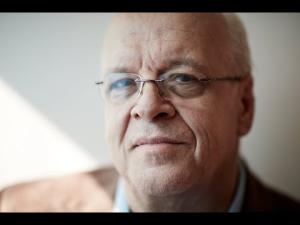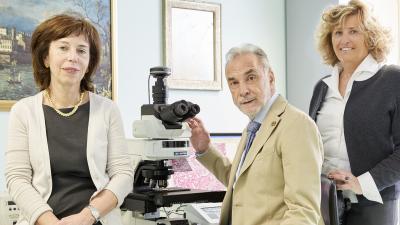Lars Liljeryd
Digital audio compression
Finalist for the European Inventor Award 2017
Spectral band replication (SBR) is a novel method for compressing digital audio files that has made it possible for millions of people around the world to enjoy higher-quality sound conveniently and affordably. It was conceived by Swedish inventor Lars Liljeryd and taken from drawing board to market with the help of a team of engineers that included Martin Dietz from Germany and Kristofer Kjörling, Per Ekstrand and Fredrik Henn from Sweden. Without SBR, many of today's smartphones, portable music devices, digital radios, video cameras, TVs and personal computers would be much less efficient at downloading, storing and streaming audio media.
Liljeryd's ideas revolutionised an entire industry. His concept for improving upon existing coding formats raised the bar for digital audio technology to levels never thought possible. It expanded on other audio compression techniques, notably MP3 and Advanced Audio Coding (AAC), which many experts believed had already reached their full potential. And, probably most important to the wide, global audience that relies on SBR - and to the music aficionado who developed it - SBR ensures that music still sounds really, really good.
Societal benefit
Hitting the market in full stride in 2002 as part of the MPEG High-Efficiency Advanced Audio Coding standard (HE-AAC), SBR came at a time when bandwidth and storage space were not keeping up with the public's love of music and streaming radio. In one fell swoop, SBR improved audio compression by 30-50%, effectively doubling the music that could be saved on a device or the speed at which it could be transmitted.
SBR's efficiency and high fidelity quickly won over satellite broadcasting, mobile phone and internet companies. It was soon added to popular music players, most notably Apple's iTunes, and supported by multimedia plug-ins like Adobe Flash Player. People in the US might know SBR from streaming music services like Pandora Radio or Rhapsody as well as from satellite radio services such as SiriusXM. Europeans are more likely to have used it on the Digital Radio Mondiale broadcasting network, which includes Deutsche Welle, BBC World Service and Radio France Internationale. SBR is also used to compress audio in digital TV broadcasting signals in many countries.
Now standard on an estimated six billion devices around the globe, ranging from video cameras to smartphones and personal computers, if ubiquity alone is indicative of societal benefit, then SBR has the numbers to support it. However, SBR's true value is the high sound quality it provides while paring down storage and transmission space, giving a global audience a wider choice and greater control of the music and audio programmes they listen to.
Economic benefit
Llijeryd created a small start-up with three master's graduates - Kjörling, Ekstrand and Henn - to begin realisation of his initial idea. He then sought help from specialists at the Fraunhofer Institute in Erlangen, Germany, which had developed both MP3 and AAC, to help integrate SBR into these codecs. With some additional investment capital, Liljeryd formed Coding Technologies AB in Sweden and - together with the Fraunhofer institute - its German subsidiary Coding Technologies GmbH and hired Fraunhofer's MP3 specialist Dietz to head both companies.
In 2002, SBR was successfully integrated into HE-AAC, which remains one of the most popular MPEG-standardised audio codecs. Five years later, Coding Technologies, along with its key SBR patents, was acquired by US-based Dolby Laboratories - a leading company for audio encoding/compression and audio noise reduction - for approximately EUR 170 million (at 2007 rates).
This acquisition was the key to the mass licensing of SBR technology. Dolby, with annual sales of around EUR 950 million, is one of the leading companies in the audio codec market, which was valued at EUR 5.2 billion in 2015 and is expected to reach almost EUR 7 billion by 2022, according to industry analysts.
Aside from directly employing around 100 audio coding experts in Stockholm and Nuremberg to support refinement and future upgrades of SBR, the coding technology also helps support software developers, products designers and manufacturers downstream.
How it works
Before Liljeryd's SBR, most digital audio files were compressed by removing parts of the original file. Digital audio files are simply sound waves that have been encoded into bits, i.e. 1's and 0's, so shrinking their overall size meant cutting certain frequencies. Usually it was the very highest and lowest frequencies that were removed. This method was effective at shrinking the overall size of the file, but after a certain level (90% compression for AAC), it sacrificed audio quality.
Liljeryd's stroke of genius came when he realised that he didn't need to transmit all the bits of a file to maintain sound quality. It was enough to transmit only the lower frequencies and use these as a guide to recreate the high-pitched parts. A song could be deconstructed, parts of it sent with instructions for the rest, and then the whole thing could be rebuilt at the receiving end.
The inventor
From an early age Liljeryd, now 66, was actively involved in music - especially rock and roll - and combined this with a fascination for electronics. If he wasn't playing drums in one of the bands he had joined, he was likely to be experimenting with ham radio or amplifiers, even selling simple crystal radios to friends. By 1971, he had set up his first business to rebuild Hammond organs, giving them a more "rocking" sound. In 1973, one of his bands had a No. 1 hit in Sweden, forcing him to take time off from his day job as a sound studio engineer to go on tour.
Then starting in the 1980s, Liljeryd was responsible for a string of sound-related innovations: a deep-diver communication system for the offshore oil industry, for which he won an ocean technology prize, a portable high-sensitivity capacitive hydrophone system used by the Swedish navy, and a digital hearing-aid system. The seeds of SBR actually lay in this hearing-aid project, where Liljeryd was reminded that the human auditory system is less sensitive to higher frequencies. This gave him the flexibility to replicate higher frequencies, based on an acoustic phenomenon known as harmonic redundancy, without having to worry about achieving granularity that would be imperceptible to the human ear.
Did you know?
Audio and video coding inventors have done well at the European Inventor Award over the years. Liljeryd joins the ranks of Karlheinz Brandenburg (2006; Lifetime achievement - finalist), regarded by many as the father of digital audio compression and one of the main forces at the Fraunhofer Institute behind MP3, as well as Leonardo Chiariglione (2008; Lifetime achievement - finalist), who both established the MPEG codec and pushed for video standards that led to HDTV. In a similar vein, Kornelis A. Schouhamer Immink (2015; Lifetime achievement - finalist) was instrumental in the development of EFM, the data coding behind CDs, DVDs and minidiscs.
Media gallery
Patent numbers:
Contact
European Inventor Award and Young Inventors Prize queries:
european-inventor@epo.org Subscribe to the European Inventor Award newsletterMedia-related queries:
Contact our Press team#InventorAward #YoungInventors








